What the Saints Say
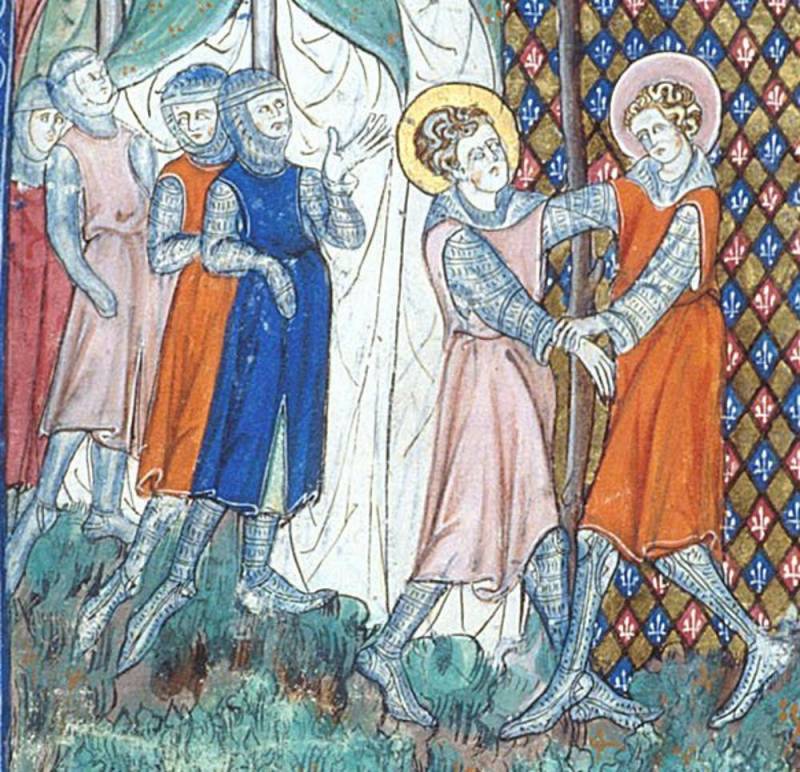
holy, innocent, blameless,
separated from sinners and exalted above heaven.
The Epistle to the Jews of the Apostle Paul, 7:26
History and culture. We have already talked about the fact that illustrations - book miniatures from medieval manuscripts - are the most valuable sources of our knowledge about the Middle Ages. Although, of course, in this case, there is an integrated approach: archaeological sites are studied, then they are compared with images in dated manuscripts, then attention is drawn to the descriptions of certain armor in the inventory of castles, as well as "invoices" for payment for custom-made armor .
Ideally, if the armor has survived to this day, there are descriptions of it in the inventories, as well as documents for ordering or paying, as well as its drawing in special books - "advertising booklets" of the past. There is no armor - there are effigies, that is, three-dimensional tomb figures. There are no effigies - there are planar images, the so-called breaststrokes. In any case, their dating and the dating of drawings of similar armor in manuscripts, also dated, matters.
This is how the chronology of the development of medieval weapons was gradually compiled. Moreover, it is important to note that among the illustrations, not only those that are directly devoted to the depiction of warriors in armor are important, but also those where they are depicted, so to speak, indirectly, and the characters of the illustrations are completely different characters. For example, the saints, who in the Middle Ages were constantly depicted in such manuscripts as numerous psalters, books of hours and bibles. Let's take a look at the pages of these most interesting books and see what the... saints depicted on them can tell us!
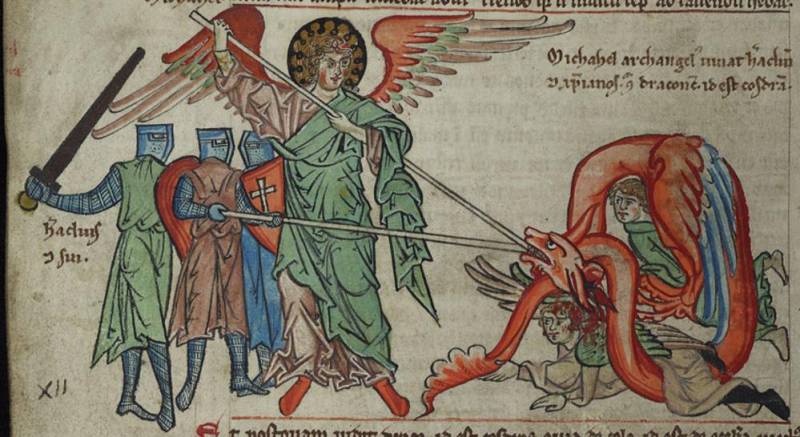
Let's start with the image of St. Michael from the Exposition of the Apocalypse, painted in Germany, dated 1249-1250. The dragon and St. Michael himself are unimportant for us, but the three warriors on the left look like the characters in the movie "Alexander Nevsky" (1938), but simpler, much simpler ... "Apocalypse Exposition", Cambridge University Library
Saint Lawrence. Let's not pay attention to the torments of this saint (and he, refusing to worship the pagan gods, was roasted alive on an iron grate with hot coals, and the servants pressed his body to it with horns), but let's look at the soldiers above. And although they are very small, it is obvious that they are wearing traditional hauberks, surcoats and triangular shields.

Miniature "Execution of St. Lawrence on slow fire", 1250-1260. Paris, France, Limoges French Multimedia Library
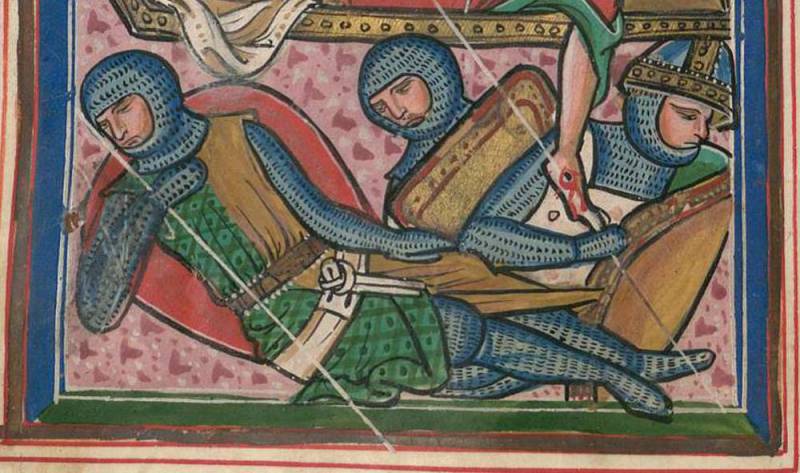
And here is a miniature dedicated to the popular theme: "Christ rising from the tomb." Naturally, his guards are asleep and see nothing at all. But we see that the warrior in the foreground is dressed like a real knight, and not from the poor, because he is wearing a surcoat-miparti, that is, made up of two different fabrics. The baldric of the sword is written out in the most careful way, so it is quite possible that this is a drawing from life, or the artist knew perfectly well how the sword baldric is tied. Psalter. Miniature "Christ rising from the tomb", 1265 Magdeburg, Germany. Bavarian State Library, Munich
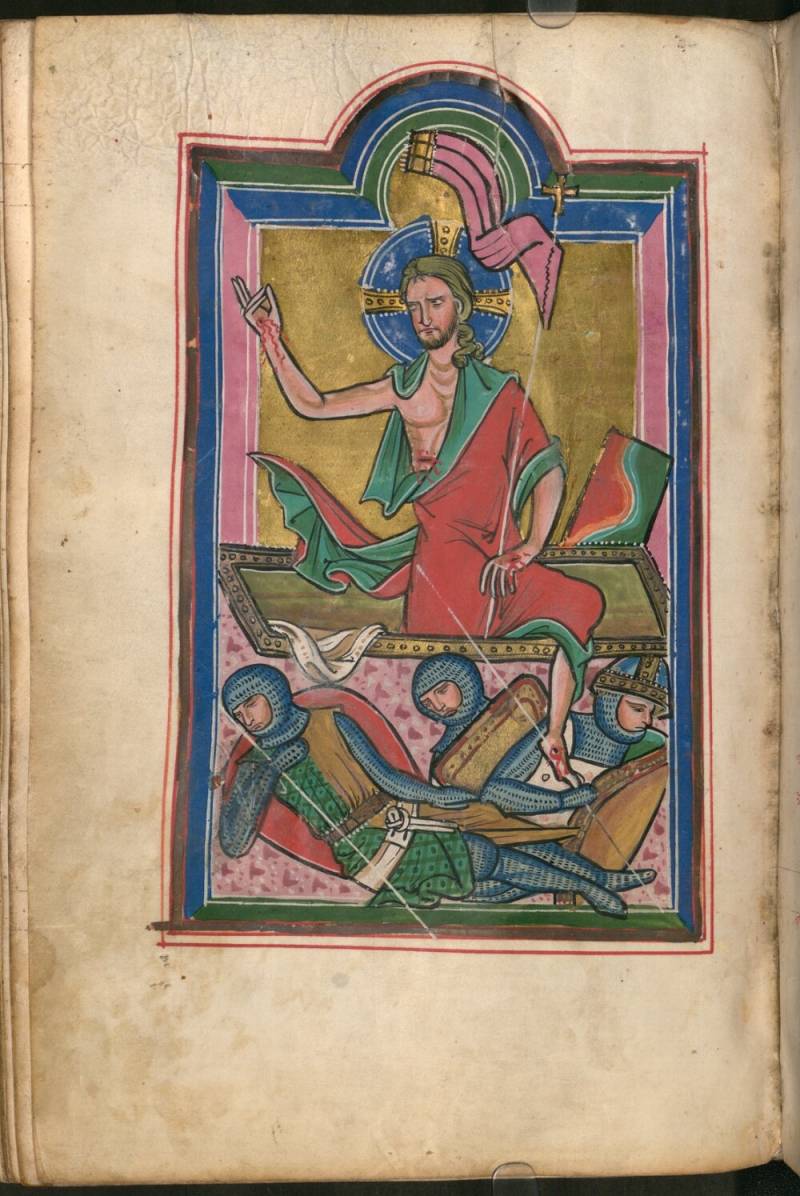
So this "picture" looks completely ...
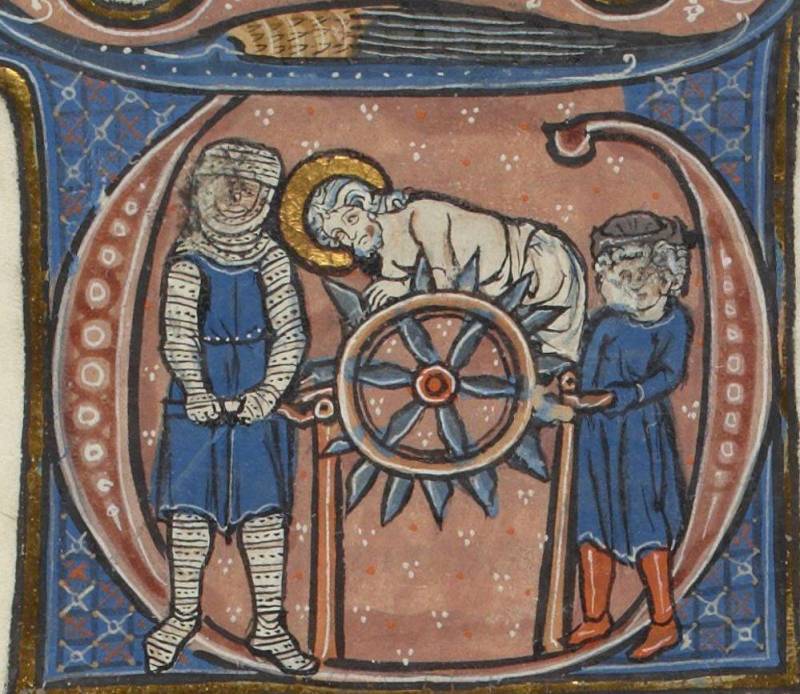
The Christian Church also knows seven St. deacons. The suffering of one of them is shown in this initial miniature. It is small in size. But it is clearly seen that the warrior on the left has a canonical appearance, just like the warriors of this time on other miniatures (and let's add - effigies) of this era. Lives of the Saints, 1288 National Royal Library of Belgium, Brussels

In this illustration we see the meeting of two saints. One of them is St. Eustace. Half a century has passed since the appearance of our first illustration, and the appearance of the warriors has not changed much, has it? "Life of Eustace and Other Saints", 1300-1325 Paris, France. British Library, London
Saint George or George on miniatures, as well as on statues and coats of arms, is easier to recognize than other saints. It is customary to depict him on a horse, in armor (of course, every time in the armor of his time) and in addition, he also very often strikes a dragon.
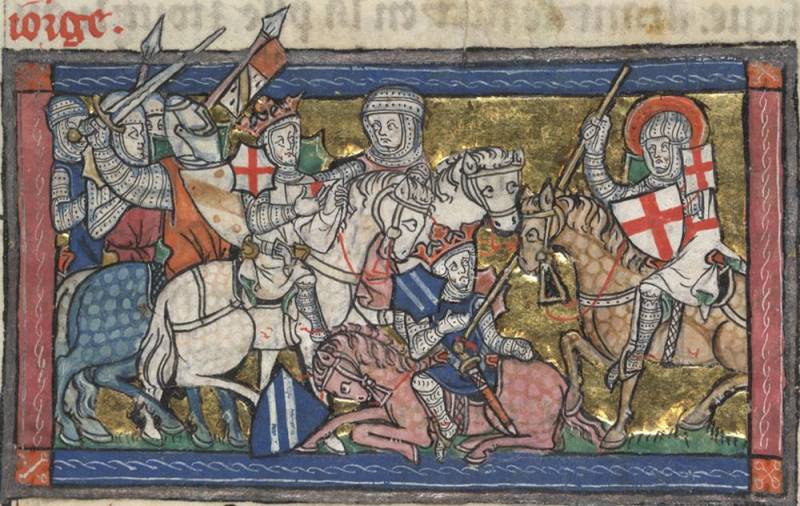
Illustration from the manuscript "History of the Holy Grail", 1310-1320. Philosophy Hermetic Library, Amsterdam
This miniature is interesting in that the armor and weapons of the warriors on it do not differ from the images of the XNUMXth century, with the exception of one detail: armorial shields - elets - appeared on the shoulders of the warriors. And some of them have a very whimsical shape. The Cross of Saint George is red on a white field.
The miniatures very clearly show the changes in weapons that occur over time. Here, for example, the image of St. Mauritius. He led the Roman legion, was martyred for refusing to persecute Christians, and from the XNUMXth century was considered the patron saint of knights. Therefore, he is often depicted with a sword. The miniature dates back to the end of the XNUMXth century and on it at St. Mauritius we see a bascinet helmet with a “dog muzzle” visor, a short jupon and a full plate cover for the legs. But only some half a century has passed since the writing of the manuscript about the Holy Grail ...
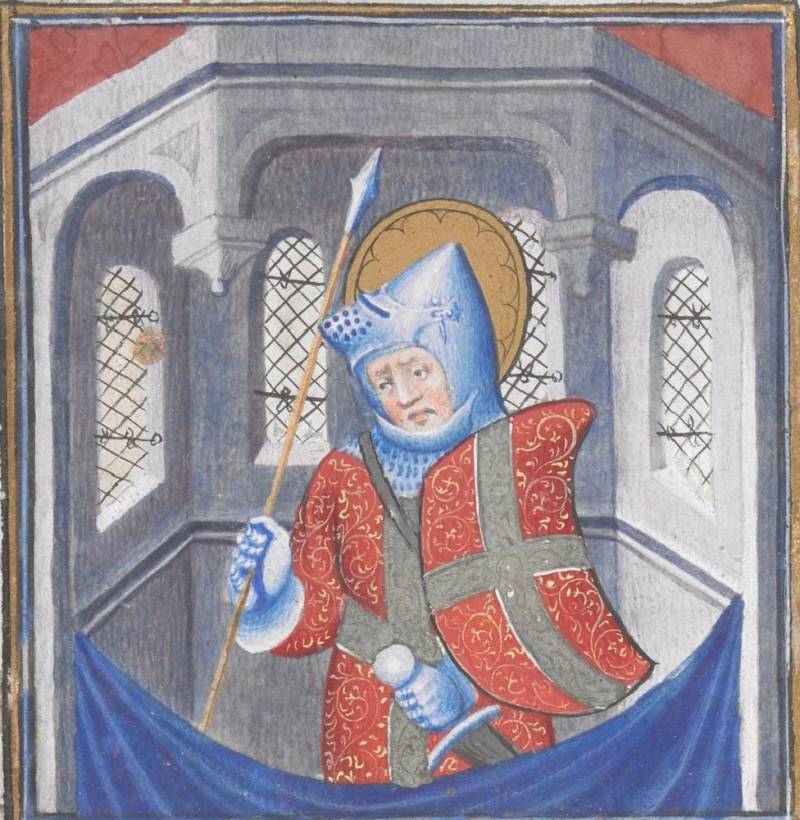
"Saint Mauritius" from René of Anjou's Book of Hours 1405-1410 looks just like a participant in the Battle of Grunwald. The shield is completely different! It differs from St. George by a red robe and a white cross. Paris, France. British Library, London
Next in the row of "our" saints is St. Adrian. And if we look at his image in a miniature of 1400–1450, then the conclusion can be unambiguous: the illuminator who designed this book saw the knights only from afar, or maybe he was so lazy or drunk that he decided - “it will do.” and so, ”the main thing is the radiance from the head!
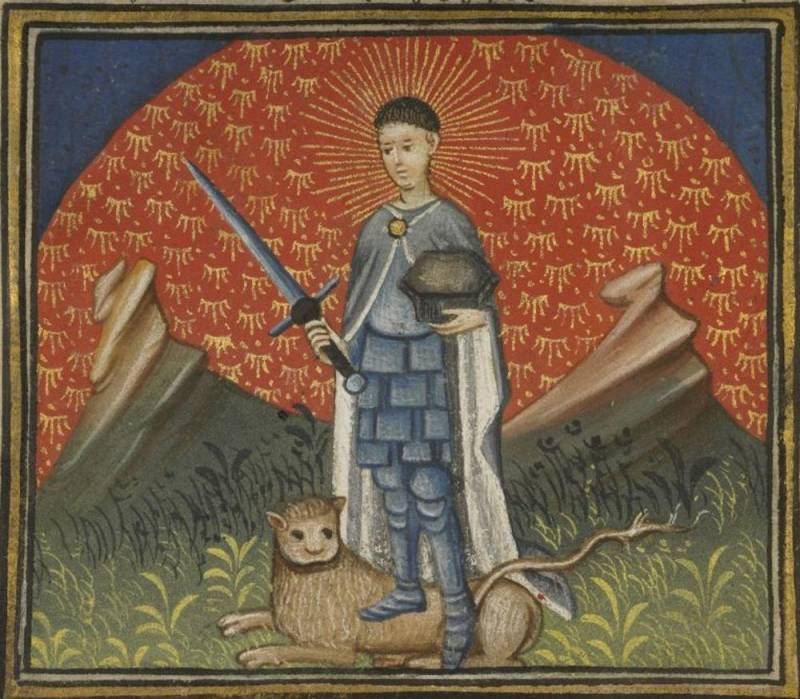
Miniature from the Saint Adrian manuscript, 1400-1450. France. Municipal Library of Boulogne-sur-Mer
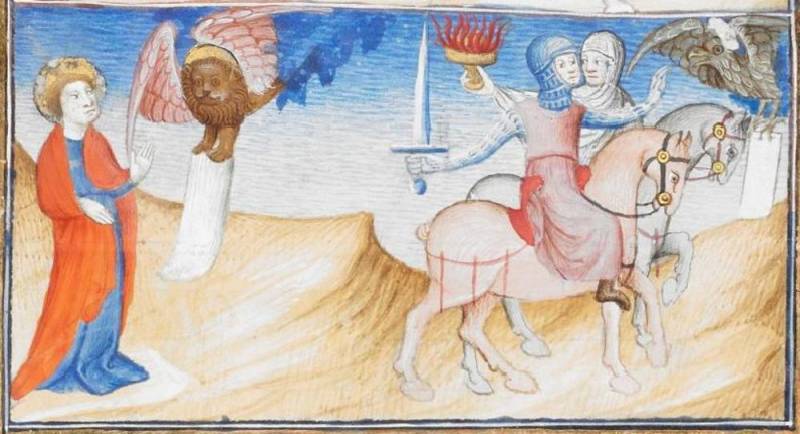
A very interesting image of St. Luke from the "Bible History", referring to 1411. Look at the warriors! They do not correspond to the specified year at all. Most likely, the artist redrawn this scene from an older manuscript. France, British Library, London
Saint Victor of Marseilles is not as well known here in Russia as in the West. However, he is revered both there and here. Just in different forms. Catholics venerate him as a saint, and Orthodox - in the guise of martyrs. Well, then everything happened to him, as with many other first believers: being a Roman commander, he refused to sacrifice to the statue of the god Jupiter, and even kicked it with his foot. The then Emperor Maximilian did not like this, and he ordered Victor to be executed, and not just like that, but in a very sophisticated way - laying it between the millstones.
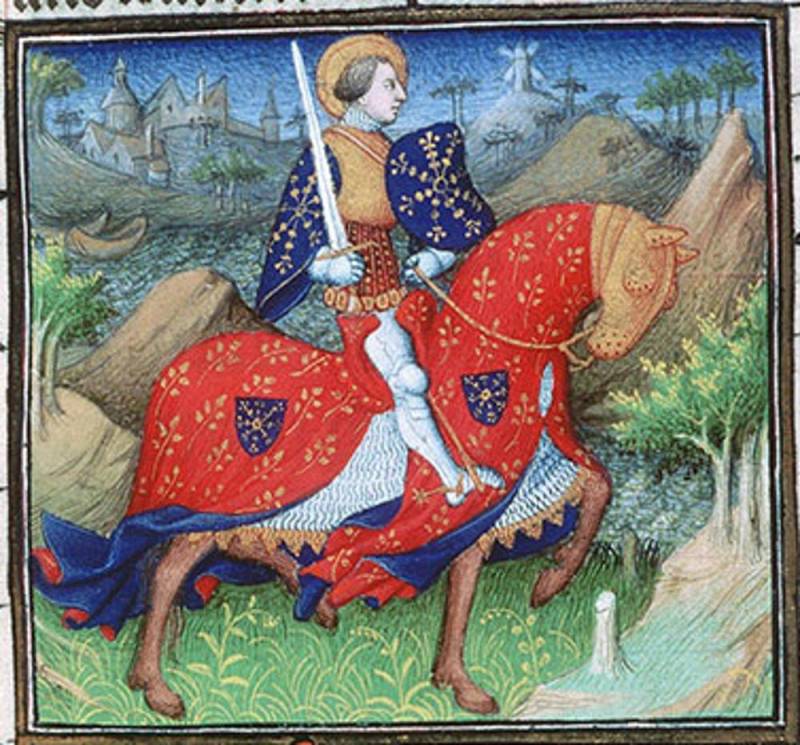
Illustration depicting Saint Victor of Marseilles. "Paris Breviary", 1414 Paris, France. The Equinox Municipal Mediatheque is one of 18 libraries in the Indre department located in the commune of Châteauroux, France
In this miniature, Victor looks like a real knight with a coat of arms and on a horse also covered with a coat of arms. Under the blanket of fabric - a blanket of chain mail! The horse's head is protected by a complex gilded mask, most likely made of leather. Victor's torso over the armor closes the jupon. This fashion of wearing armor was typical for this time.
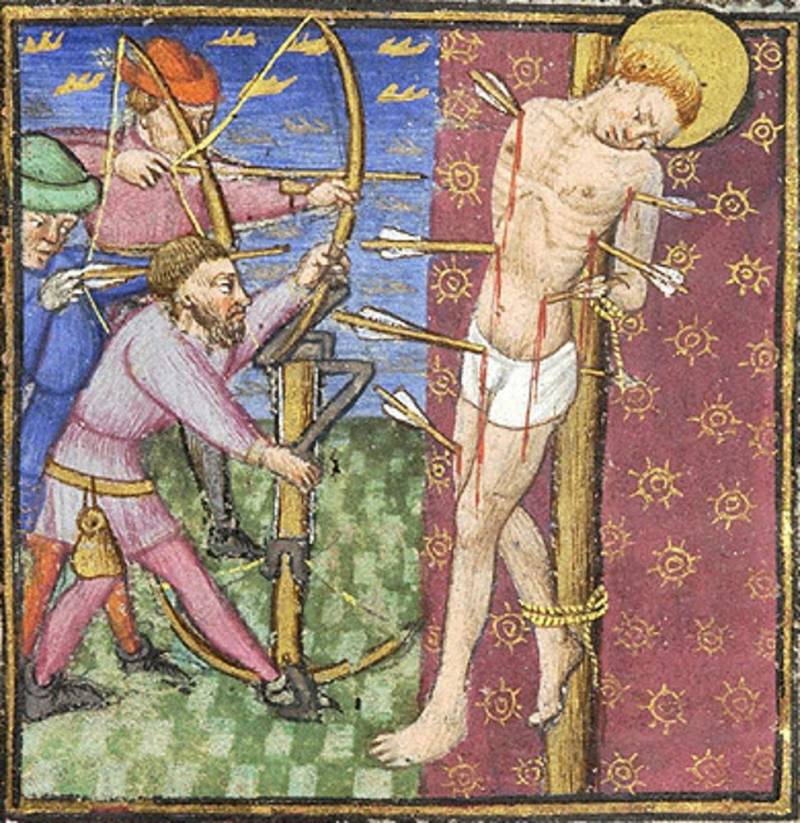
Book of Hours 1433-1434 Angers, France. Morgan Library, New York
Saint Sebastian was a famous martyr for the faith, and much cannot be squeezed out of this illustration in this case. Except one: in 1433-1434. - Namely, at this time the book of hours with this miniature was written, crossbows with the so-called English collar still continued to be used.
An interesting source is the Life of Saints Edmund and Fremund, 1433–1434. The first was the king of England in the ninth century, and the Vikings shot him with bows; the other lost his head. In this illustration from this manuscript, we see typical knights in "white armor" with "skirts" of metal stripes and wearing "grand bascinet" helmets. Swords in one and a half hands - yes, typical for this time, however, two truly huge felchens (falchions) attract attention, which ... have never been found anywhere and, alas, have not reached our time.
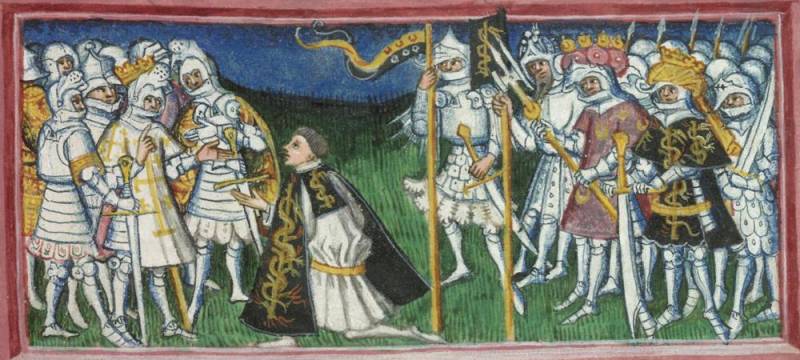
"St. Edmund "" Life of Saints Edmund and Fremund", 1433-1434. Bury St Edmunds, England. British Library, London
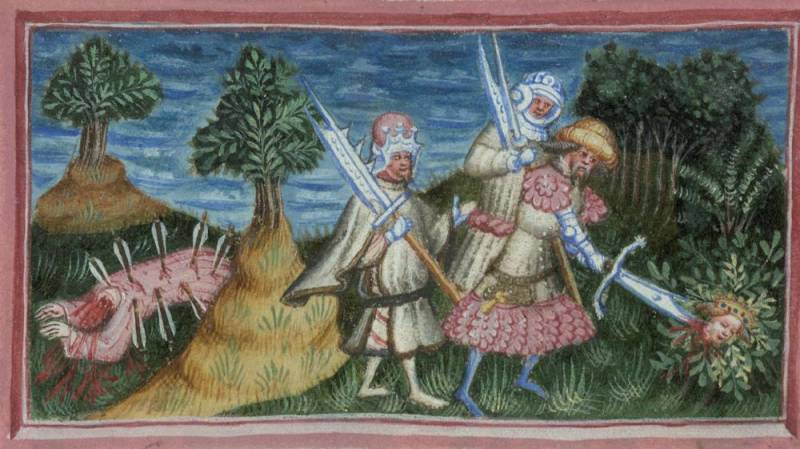
However, the portholes of those years did not shy away from a certain amount of fantasy in their images. Miniature from the same manuscript...
Another saint, usually depicted with a sword in his hand, is Martin of Tours, who cut his cloak with it and gave half to the beggar. They draw him in the clothes of a city dweller, since he was not a warrior, but the sword (directly according to E. Oakeshott) changes from century to century.
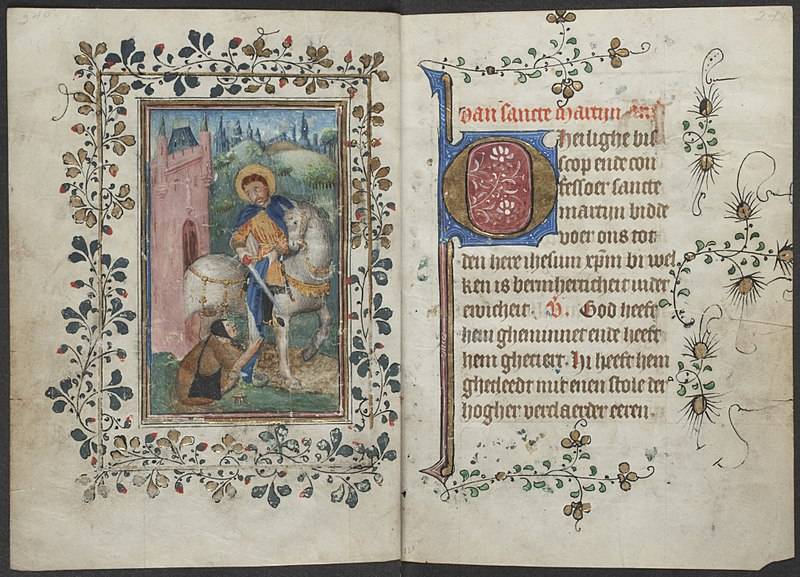
"Master Zweder van Culemborg's Book of Hours" (Illuminator: Zweder van Culemborgh, c. 1415–1440). The full-page miniature depicts Saint Martin, Bishop of Tours, sharing his cloak with a beggar. Publication date around 1430. Manuscript with illustrations on parchment. Royal Library of the Netherlands
Hence the conclusion: this is how the dating of past eras is established. Very slowly and painstakingly. But… there is no other way, it just won't work.
PS
By the way, it is St. Martin, or rather his statue, that plays one of the key roles in Paul Verhoeven's film "Flesh and Blood" ... And there is enough of something, but there is enough flesh and blood!
Information